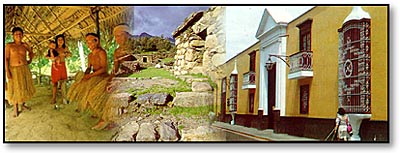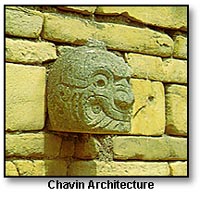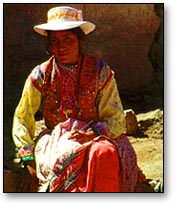
History & Culture
Peru
is best known as the heart of the Inca empire, but it was home to many
diverse indigenous cultures long before the Incas arrived. Although
there is evidence of human habitation in Peru as long ago as the eighth millennium
BC , there is little evidence of organized village life until about 2500
BC. It was at about
this time that climatic changes in the coastal regions prompted Peru's early
inhabitants to move toward the more fertile interior river valleys. For
the next 1500 years, Peruvian
civilization developed into a number of organized cultures, including the
Chavěn and the
Sechěn. The Chavěn are best known for their stylized religious iconography, which
included striking figurative depictions of various animals (the jaguar in particular) and
which exercised considerable influence over the entire coastal region. The Sechěn
are remembered more for their military hegemony than for their cultural achievement.
The decline of the Chavěn and Sechěn cultures around the 5th century BC gave
rise to a number of distinctive regional cultures. Some of these, including
the Saliner and the
Paracas, are celebrated for artistic and technological advances such as kiln-fired
ceramics and sophisticated weaving techniques. From the Paracas arose the
Nazca, whose legacy includes the immense and cryptic Nazca Lines. However,
the accomplish- ments of
these and other early Peruvian civilizations seem today to pale in comparison
to the robust pre-Columbian civilization of the Inca.
The most startling feature of the great Inca empire was its brevity. In 1430, the realm of
the Inca consisted of little more than the river valley around Cuzco. Less than a century
later, through conquest and a canny policy of incorporating the best features of the
societies they subjugated, the Incas controlled a vast territory of almost 1 million
square kilometers--a dominion that extended from northwest Argentina to southern Colombia.
The Incan capital, at Qosqo, was undoubtedly the richest city in all of the Americas, with
temples literally sheathed in heavy gold plate. Although Qosqo's architecture remains only
in fragments and foundations, the architectural accomplishment of the Inca's has survived
intact at the astounding ceremonial centre of Machu Picchu.
In 1532, at the height of its power, the Inca empire was driven by a war of succession. In
one of the great tragedies of history, it was at precisely this moment that Francisco
Pizarro and his band of Spanish conquis- tadors arrived on the scene. Showing an uncanny
ability to turn circumstances to his own advantage, Pizarro used deception and guile to
gain a personal meeting with Atahualpa, the Inca ruler, whom he coolly assassinated. In
the face of fierce resistance, Pizarro and his men seized Cuzco and sacked the city.
Although the Incas continued to fight for the next several years, their empire had ended
and Spanish rule had begun.
Peru's population of about 23 million is divided almost equally between the highlands and
the population centres of the coast, and the division marks a sharp cultural as well as
geographic divide. The inland  regions are marked by extreme
poverty and subsistence agriculture, while the fertile river valleys of the lowlands have
produced a wealthier, more cosmo- politan culture. Almost half of Peru's people are
Indian, while another one third or so are mestizo. About ten percent are of European
descent, and there are significant African and Asian minorities. Although Spanish is
Peru's official language, a multitude of indigenous languages continue to hold sway in the
highlands.
regions are marked by extreme
poverty and subsistence agriculture, while the fertile river valleys of the lowlands have
produced a wealthier, more cosmo- politan culture. Almost half of Peru's people are
Indian, while another one third or so are mestizo. About ten percent are of European
descent, and there are significant African and Asian minorities. Although Spanish is
Peru's official language, a multitude of indigenous languages continue to hold sway in the
highlands.
Copyright (c) 1998 - 2007 interKnowledge Corp. All rights reserved.
